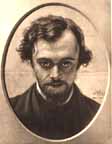
he term Pre-Raphaelite, which refers to both art and literature, is confusing because there were essentially two different and almost opposed movements, the second of which grew out of the first. The term itself originated in relation to the Pre-Raphaelite Brotherhood, an influential group of mid-nineteenth-century avante garde painters associated with Ruskin who had great effect upon British, American, and European art. Those poets who had some connection with these artists and whose work presumably shares the characteristics of their art include Dante Gabriel Rossetti, Christina Rossetti, George Meredith, William Morris, and Algernon Charles Swinburne.


William Holman Hunt's portraits of his young Pre-Raphaelite Brothers John Everett Millais and Dante Gabriel Rossetti. [Click upon thumbnails to obtain larger images.]
The Pre-Raphaelite Brotherhood (PRB) was founded in 1849 by William Holman Hunt (1827-1910), D.G. Rossetti, John Everett Millais (1829-1896), William Michael Rossetti, James Collinson, Thomas Woolner, and F. G. Stephens to revitalize the arts. (Even though William and Michael's sister, Christina, never was an official member of the Brotherhood, she was a crucial member of the inner circle. Although the young would-be art revolutionaries never published a manifesto, their works and memoirs show that having read Ruskin's praise of the artist as prophet, they hoped to create an art suitable for the modern age by:
1. Testing and defying all conventions of art; for example, if the Royal Academy schools taught art students to compose paintings with (a) pyramidal groupings of figures, (b) one major source of light at one side matched by a lesser one on the opposite, and (c) an emphasis on rich shadow and tone at the expense of color, the PRB with brilliant perversity painted bright-colored, evenly lit pictures that appeared almost flat.
2. The PRB also emphasized precise, almost photographic representation of even humble objects, particularly those in the immediate foreground (which were traditionally left blurred or in shade) --thus violating conventional views of both proper style and subject.
3. Following Ruskin, they attempted to transform the resultant hard-edge realism (created by 1 and 2) by combining it with typological symbolism. At their most successful, the PRB produced a magic or symbolic realism, often using devices found in the poetry of Tennyson and Browning.
4. Believing that the arts were closely allied, the PRB encouraged artists and writers to practice each other's art, though only D.G. Rossetti did so with particular success.
5. Looking for new subjects, they drew upon Shakespeare, Keats, and Tennyson.

Arthur Hughes (after a sketch by William Holman Hunt). The Pre-Raphaelite Meeting. 1848 [Click upon thumbnail to obtain larger image.]
In addition to the formal members of the PRB, other artists and writers formed part of a larger Pre-Raphaelite circle, including the painters Ford Madox Brown and Charles Collins, the poet Christina Rossetti, the artist and social critic John Ruskin, the painter-poet William Bell Scott, and the sculptor poet John Lucas Tupper. Later additions to the Pre-Raphaelite circle include J. W. Inchbold, Edward Burne-Jones, William Morris — and even J. M. Whistler.
The Second Stage of the Movement: Aesthetic Pre-Raphaelitism
The second form of Pre-Raphaelitism, which grows out of the first under the direction of D.G. Rossetti, is Aesthetic Pre-Raphaelitism, and it in turn produced the Arts and Crafts Movement, modern functional design, and the Aesthetes and Decadents. Rossetti and his follower Edward Burne-Jones (1833-1898) emphasized themes of eroticized medievalism (or medievalized eroticism) and pictorial techniques that produced moody atmosphere. This form of Pre-Raphaelitism has most relevance to poetry; for although the earlier combination of a realistic style with elaborate symbolism appears in a few poems, particularly those of the Rossettis, this second stage finally had the most influence upon literature. All the poets associated with Pre-Raphaelitism draw upon the poetic continuum that descends from Spenser through Keats and Tennyson — one that emphasizes lush vowel sounds, sensuous description, and subjective psychological states.
Pre-Raphaelitism in poetry had major influence upon the writers of the Decadence as well as upon Gerard Manley Hopkins and W.B. Yeats, both of whom were also influenced by Ruskin and visual Pre-Raphaelitism.
Related Material
- New chemistry, new colors — scientific discovery and Pre-Raphaelite painting
- The Pre-Raphaelites (by a Post-Raphaelite) from the 1862 Fun
- Parodies of Millais and other The Pre-Raphaelites in Fun
Originally created 1989; last modified 15 November 2020